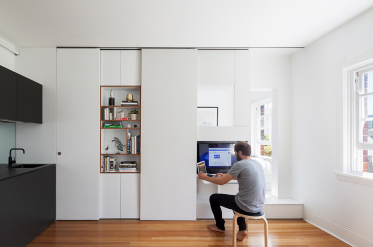
The stunning and functional Cosm chair
The home office is becoming an important inclusion to the residential landscape due to the rapidly growing self-employed and the flexible workforce blurring the lines between the home and the workspace.
Over the past few years, commercial office design has leant heavily on the design influence of the home. Working spaces have become more casual, with fully fitted-out kitchens to meeting spaces with furniture more akin to the lounge room. However, we are starting to see residential design looking towards commercial spaces to ensure space functionality and appropriate furniture choices are being implemented in the home.
This is being driven by demand. Twenty-five percent of Australians are calling home “the office” at least one day a week, whether this is working for themselves or others. Among them, 2.8 million self-employed people consider home their primary place of work, according to consultancy Global Workplace Analytics. That is a huge market that architects, interior designers and product designers are seizing on to ensure the home office is a functional, enjoyable, productive and healthy environment.

A fresh, segregated space featuring the Herman Miller Aeron chair
An important research study was released recently. ‘The impact of the open workspace on human collaboration’ saw Harvard researchers study two Fortune 500 companies planning to make the switch to open-plan offices by comparing how employees interacted both before and after the new office design, using electronic badges and microphones to monitor employee interactions, and to track changes in email use.
The academics found that employees in offices that had removed spatial boundaries were actually less collaborative, spending 72 percent less time in face-to-face interactions than prior to the removal of the walls and enclosed spaces. Anecdotal evidence is pointing to a change in the home office, moving away from just a simple desk in a busy thoroughfare with a dining chair, to something far more customised with appropriate furniture.
Task chairs that were once just the domain of the traditional workplace are now finding their way into the home, thanks to changes in the design, allowing highly technical and functional office chairs to sit comfortably in the home. The Cosm Chair by Herman Miller is a prime example of a design aesthetic and function that means the chair fits both works spaces seamlessly.

The Cosm Chair also comes in varying sizes allowing it to be used for children's study nooks which is a smart investment considering the hours spent moving through varying educational phases. And it's completely feasible to buy an office chair that will last for your children's primary, secondary and tertiary education. This is a classic case of invest now and reap rewards for decades.
The chair’s frame and fabric suspension work in tandem with an auto-harmonic tilt feature – this means that it responds intuitively to the person using it, their unique contours and movements – delivering uninterrupted support and thermal comfort for years to come. Even elements like its hourglass-shape provide areas of high and low tension, giving comfort to wherever it is needed most. The tilt alone doesn’t make Cosm the designers’ most refined design to date; a meticulous process of prototyping hundreds of hand-sculpted and 3D-printed parts paved the path towards a seating experience unlike any other.
For the Berlin-based designers at Studio 7.5 – Carola Zwick, Roland Zwick and Burkhard Schmitz – the Cosm represents something of a holy grail: a design that creates a new reference point for instant, personalised comfort. The Auto-Harmonic Tilt in particular has been a goal they’ve worked toward for years.

The design team in the early stages. Image courtesy of Studio 7.5
Desks are also of equal importance and one such example for a dedicated home office space is the the Airia Desk, which is designed specifically to create a work space within a home environment. It's a functional desk with cord management, storage drawers and a durable work surface, whilst also being a beautiful designer piece you're happy to display in your home. For an alternative, where the space needs to be more flexible for smaller residential footprints, The Carafe Table, designed by a leading local designer Charles Wilson, is the communal vessel from which the table takes its name. Carafe embodies the convivial spirit present when family and friends gather. It’s another wonderful example of furniture that adds value, function and spirit whatever the setting.

The Carafe table by Charles Wilson provides an entirely flexible and elegant workspace for the home
The move towards a higher quality profile fit out and furniture inclusions is ensuring that the home office is a place where productivity and health can be measured, which will become an increasing requirement from clients as the growth of the flexible work force continues to grow.
WRITTEN BY HouseLab




